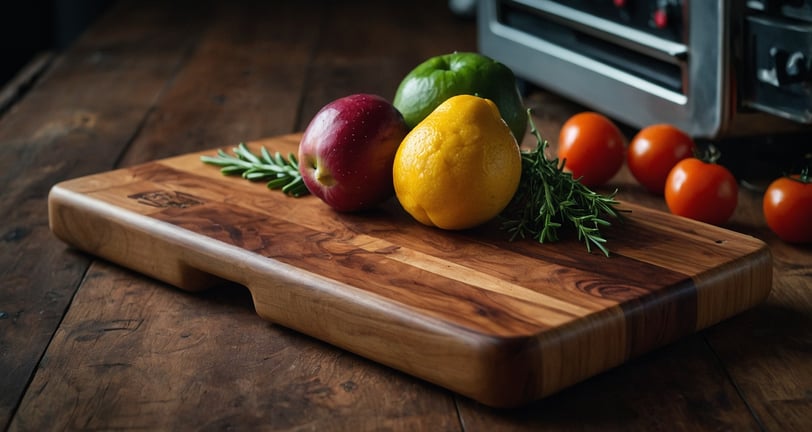The Ultimate Guide to Wooden Cutting Boards
Care, Maintenance, and Benefits of Wooden Cutting Boards


Wooden cutting boards are a timeless kitchen essential that offers durability, elegance, and functionality. As the centerpiece of food preparation, choosing the right cutting board can enhance your culinary experience while protecting your knives. In this guide, we will delve into everything you need to know about wooden cutting boards, including their benefits, types, proper care, and tips for maintaining their longevity.
Why Choose a Wooden Cutting Board?
Wooden cutting boards have stood the test of time for good reason. Here are some compelling benefits:
Gentle on Knives: Unlike glass or ceramic boards, wooden cutting boards preserve the sharpness of your knives, reducing wear and tear.
Durability: High-quality wooden boards, such as those made from maple, walnut, or cherry, can last for decades with proper care.
Natural Antibacterial Properties: Studies have shown that wood has natural antimicrobial properties, making it a safe choice for food preparation.
Eco-Friendly: Wooden cutting boards are biodegradable and often crafted from sustainably sourced materials, making them an environmentally conscious option.
Aesthetic Appeal: A wooden cutting board adds warmth and charm to any kitchen, doubling as a serving platter for cheese or charcuterie.
Types of Wooden Cutting Boards
Understanding the different types of wooden cutting boards can help you choose the best option for your kitchen:
End Grain Boards:
Recognizable by their unique checkerboard pattern.
Known for being gentle on knives and self-healing, as the wood fibers close up after cuts.
Edge Grain Boards:
Features parallel wood strips running along the length of the board.
Slightly more affordable than end grain boards but still durable and stylish.
Flat Grain Boards:
Made from wide, flat wood planks.
While less expensive, they are more prone to warping and scratches over time.
How to Care for Your Wooden Cutting Board
Proper maintenance is key to preserving the beauty and functionality of your wooden cutting board. Follow these simple steps:
1. Cleaning
After each use, wash your wooden cutting board with warm water and mild dish soap.
Avoid soaking the board, as excessive water can cause warping or cracking.
Dry immediately with a clean towel and allow it to air dry upright.
2. Sanitizing
To sanitize, sprinkle coarse salt on the board and scrub it with a halved lemon. This method removes stains and kills bacteria naturally.
Alternatively, use a mixture of white vinegar and water for regular sanitization.
3. Oiling
Keep your wooden cutting board hydrated by applying food-grade mineral oil every few weeks.
Spread the oil evenly with a clean cloth and let it soak overnight before wiping off excess oil.
4. Avoiding Damage
Never put your wooden cutting board in the dishwasher, as the heat and moisture can ruin the wood.
Avoid cutting on the same area repeatedly to prevent deep grooves.
Tips for Extending the Lifespan of Wooden Cutting Boards
1. Rotate the Board:
Use both sides of your cutting board to distribute wear evenly.
2. Use Separate Boards:
Consider dedicating one board for raw meat and another for fruits, vegetables, or bread to avoid cross-contamination.
3. Sand Down Surface Imperfections:
If your board develops scratches or uneven surfaces, lightly sand it with fine-grit sandpaper and reapply mineral oil.
Common Myths About Wooden Cutting Boards
Let’s dispel a few misconceptions surrounding wooden cutting boards:
Myth 1: Wooden Boards Are Hard to Clean: Proper cleaning techniques make wooden boards easy to maintain and hygienic.
Myth 2: Plastic Boards Are Safer: Studies have shown that wood’s natural antibacterial properties make it equally, if not more, sanitary than plastic.
Myth 3: Wood Is Prone to Warping: While improper care can lead to warping, routine oiling and avoiding excess moisture prevent this issue.
How to Choose the Right Wooden Cutting Board
When selecting a wooden cutting board, consider these factors:
Wood Type:
Hardwoods like maple, walnut, and cherry are highly durable and resistant to deep cuts.
Size:
Choose a board that fits comfortably on your countertop and meets your food preparation needs.
Thickness:
Thicker boards are sturdier and less likely to warp over time.
Additional Features:
Look for boards with juice grooves to catch liquid from meats or built-in handles for easy transport.
The Environmental Impact of Wooden Cutting Boards
Using a wooden cutting board is an eco-friendly choice that supports sustainable practices. Many manufacturers source wood from responsibly managed forests, ensuring minimal environmental impact. Additionally, wooden boards last significantly longer than plastic ones, reducing waste in landfills.
Creative Uses for Wooden Cutting Boards
Beyond their primary function, wooden cutting boards can serve a variety of purposes:
Serving Platter: Use your board as a rustic base for presenting cheese, fruits, or hors d’oeuvres.
Decorative Element: Display your wooden cutting board on open shelving for a cozy kitchen aesthetic.
Photography Prop: Wooden boards make an excellent backdrop for food photography.
A Lasting Impression
A wooden cutting board is more than just a kitchen tool; it’s an investment in quality and sustainability. By selecting the right board and committing to regular maintenance, you can enjoy the benefits of this classic kitchen staple for years to come.
Whether you’re a seasoned chef or a home cook, a high-quality wooden cutting board enhances your culinary experience while adding a touch of elegance to your kitchen. With proper care, your board will remain a reliable and beautiful part of your cooking routine. Consider incorporating these tips into your kitchen habits and let your wooden cutting board shine as the unsung hero of meal preparation.
